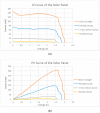Real-Time Performance of a Self-Powered Environmental IoT Sensor Network System
- PMID: 28157148
- PMCID: PMC5336020
- DOI: 10.3390/s17020282
Real-Time Performance of a Self-Powered Environmental IoT Sensor Network System
Abstract
Wireless sensor networks (WSNs) play an increasingly important role in monitoring applications in many areas. With the emergence of the Internet-of-Things (IoT), many more lowpower sensors will need to be deployed in various environments to collect and monitor data about environmental factors in real time. Providing power supply to these sensor nodes becomes a critical challenge for realizations of IoT applications as sensor nodes are normally battery-powered and have a limited lifetime. This paper proposes a wireless sensor network that is powered by solar energy harvesting. The sensor network monitors the environmental data with low-power sensor electronics and forms a network using multiple XBee wireless modules. A detailed performance analysis of the network system under solar energy harvesting has been presented. The sensor network system and the proposed energy-harvesting techniques are configured to achieve a continuous energy source for the sensor network. The proposed energy-harvesting system has been successfully designed to enable an energy solution in order to keep sensor nodes active and reliable for a whole day. The paper also outlines some of our experiences in real-time implementation of a sensor network system with energy harvesting.
Keywords: WSN; XBee; energy harvesting; environmental monitoring; performance; supercapacitor.
Conflict of interest statement
The authors declare no conflict of interest.
Figures








Similar articles
-
Plant Microbial Fuel Cells⁻Based Energy Harvester System for Self-powered IoT Applications.Sensors (Basel). 2019 Mar 20;19(6):1378. doi: 10.3390/s19061378. Sensors (Basel). 2019. PMID: 30897710 Free PMC article.
-
Energy Harvesting Chip and the Chip Based Power Supply Development for a Wireless Sensor Network.Sensors (Basel). 2008 Dec 2;8(12):7690-7714. doi: 10.3390/s8127690. Sensors (Basel). 2008. PMID: 27873953 Free PMC article.
-
Self-Sustained Autonomous Wireless Sensor Network with Integrated Solar Photovoltaic System for Internet of Smart Home-Building (IoSHB) Applications.Micromachines (Basel). 2021 Jun 2;12(6):653. doi: 10.3390/mi12060653. Micromachines (Basel). 2021. PMID: 34199450 Free PMC article.
-
Energy scavenging for long-term deployable wireless sensor networks.Talanta. 2008 May 15;75(3):613-23. doi: 10.1016/j.talanta.2007.12.021. Epub 2007 Dec 26. Talanta. 2008. PMID: 18585122 Review.
-
Software Defined Networking for Improved Wireless Sensor Network Management: A Survey.Sensors (Basel). 2017 May 4;17(5):1031. doi: 10.3390/s17051031. Sensors (Basel). 2017. PMID: 28471390 Free PMC article. Review.
Cited by
-
Adaptive Algorithms for Batteryless LoRa-Based Sensors.Sensors (Basel). 2023 Jul 21;23(14):6568. doi: 10.3390/s23146568. Sensors (Basel). 2023. PMID: 37514862 Free PMC article.
-
Reliable Control Applications with Wireless Communication Technologies: Application to Robotic Systems.Sensors (Basel). 2021 Oct 26;21(21):7107. doi: 10.3390/s21217107. Sensors (Basel). 2021. PMID: 34770413 Free PMC article.
-
Extremely Low-Profile Monopolar Microstrip Antenna with Wide Bandwidth.Sensors (Basel). 2021 Aug 5;21(16):5295. doi: 10.3390/s21165295. Sensors (Basel). 2021. PMID: 34450745 Free PMC article.
-
Analysis for Joint Delay-Power Tradeoff with Buffer/Channel-Aware and its FPGA Implementation in Wireless Sensor Networks.Sensors (Basel). 2020 May 31;20(11):3114. doi: 10.3390/s20113114. Sensors (Basel). 2020. PMID: 32486419 Free PMC article.
-
Advanced Monitoring Systems Based on Battery-Less Asset Tracking Modules Energized through RF Wireless Power Transfer.Sensors (Basel). 2020 May 26;20(11):3020. doi: 10.3390/s20113020. Sensors (Basel). 2020. PMID: 32466540 Free PMC article.
References
-
- Climent S., Sanchez A., Blanc S., Capella J.V., Ors R. Wireless sensor network with energy harvesting: Modeling and simulation based on a practical architecture using real radiation levels. Concurr. Comput. Pract. Exp. 2016;28:1812–1830. doi: 10.1002/cpe.3151. - DOI
-
- Escolar S., Chessa S., Carretero J. Energy management in solar cells powered wireless sensor networks for quality of service optimization. Pers. Ubiquitous Comput. 2013;18:449–464. doi: 10.1007/s00779-013-0663-1. - DOI
-
- Jang S., Jo H., Cho S., Mechitov K., Rice J.A., Sim S.-H., Jung H.-J., Yun C.-B., Spencer B.F., Jr., Agha G. Structural health monitoring of a cable-stayed bridge using smart sensor technology: Deployment and evaluation. Smart Struct. Syst. 2010;6:439–459. doi: 10.12989/sss.2010.6.5_6.439. - DOI
-
- Penella M.T., Gasulla M. A Review of Commercial Energy Harvesters for Autonomous Sensors; Proceedings of the IEEE Instrumentation & Measurement Technology Conference IMTC 2007; Warsaw, Poland. 1–3 May 2007; pp. 1–5.
-
- Penella M.T., Albesa J., Gasulla M. Powering wireless sensor nodes: Primary batteries versus energy harvesting; Proceedings of the 2009 IEEE Instrumentation and Measurement Technology Conference; Singapore. 5–7 May 2009; pp. 1625–1630.
LinkOut - more resources
Full Text Sources
Other Literature Sources


